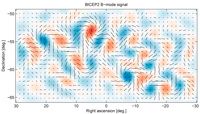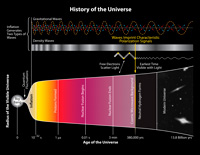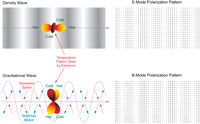BICEP2 Science Images
BICEP2 Photo Gallery
| BICEP2 Twilight | 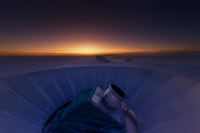
| The BICEP2 telescope at twilight, which occurs only twice a year at the South Pole. The MAPO observatory (home of the Keck Array telescope) and the South Pole station can be seen in the background. (Steffen Richter, Harvard University) |
| South Pole Dark Sector | 
| A LC-130 aircraft is passing the NSF South Pole station Dark Sector during take off. CMB telescopes visible in the background include (left to right) the South Pole Telescope, the BICEP2 telescope, and the Keck Array telescope. (Steffen Richter, Harvard University) |
| Dark Sector Lab | 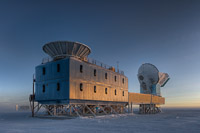
| The Dark Sector Lab (DSL), located 3/4 of a mile from the Geographic South Pole, houses the BICEP2 telescope (left) and the South Pole Telescope (right). (Steffen Richter, Harvard University) |
| Dark Sector Sunrise | 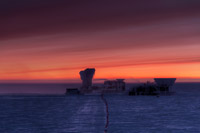
| The sun rises behind the CMB telescopes at the National Science Foundation’s South Pole Station. (Steffen Richter, Harvard University) |
| BICEP2 sunset | 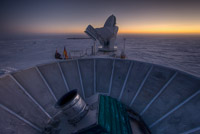
| The sun sets behind BICEP2 (in the foreground) and the South Pole Telescope (in the background). (Steffen Richter, Harvard University) |
| BICEP2 Electronics Testing | 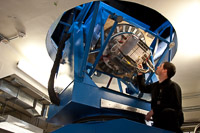
| Graduate student Justus Brevik tests the BICEP2 readout electronics from the warm environment of the Dark Sector Lab. (Steffen Richter, Harvard University) |
| BICEP2 Focal Plane | 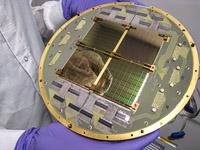
| The BICEP2 telescope's focal plane consisting of an array of 512 superconducting bolometers, designed to operate at 0.25 K (0.25 degrees Celsius above absolute zero) in order to reduce thermal noise in the detectors. The focal plane was developed and produced at NASA's Jet Propulsion Laboratory. (Anthony Turner, JPL) |
| BICEP2 Focal Plane under the Microscope | 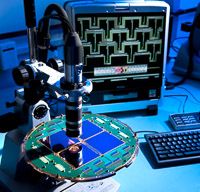
| The BICEP2 telescope's focal plane uses novel technology, developed at NASA's Jet Propulsion Laboratory, to build an array of devices that use superconductivity to gather, filter, detect, and amplify polarized radiation from the cosmic microwave background. Each pixel is made from a printed antenna sensitive to polarized millimeter-wave radiation, with a filter that determines the spectral response at 150 GHz, and a sensitive detector fabricated on a thin micro-machined membrane. The antennas and filters are made from superconducting and dielectric materials with extremely low propagation loss. The detector uses a superconducting transition-edge film as a sensitive thermometer to detect the heat from millimeter-wave radiation that was collected by the antenna and dissipated at the detector. Finally a tiny electrical current from the sensor is measured with amplifiers on the focal plane called SQUIDs (Superconducting QUantum Interference Devices). The focal planes are manufactured using optical lithography techniques, similar to those used in the industrial production of integrated circuits for computers. (Anthony Turner, JPL) |
| BICEP2 Detector | 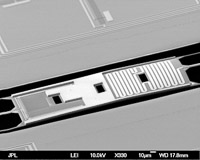
| The detector shown in this electron-beam micrograph works by converting the light from the cosmic microwave background into heat in a meandered resistor. A Titanium film tuned on its transition to a superconducting state makes a sensitive thermometer to measure this heat. The resistor and thermometer are located on an island of material, suspended in free space on tiny fibers made by a process called micro-machining. The sensors are cooled to just 0.25 degrees above absolute zero to minimize thermal noise. (Anthony Turner, JPL) |
| Arrival | 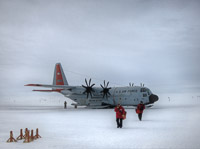
| Cryogenics technicians Kathleen Dewahl and Flint Hamblin arrive at the South Pole after a three hour flight from McMurdo Station on the coast of Antarctica. (Steffen Richter, Harvard University) |
| Liquid Helium Offload | 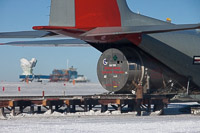
| Liquid Helium for use in BICEP2 (in the background to the right), is being unloaded from a LC-130 aircraft at the Geographic South Pole. (Steffen Richter, Harvard University) |
| Liquid Helium Delivery | 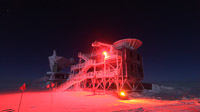
| Liquid Helium is being delivered by snowmobile to BICEP2. (Robert Schwarz, University of Minnesota) |
| BICEP2 Immersive, interactive, 360° Panorama |
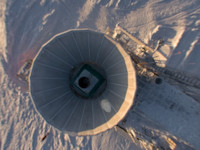
|
The Dark Sector Lab (DSL) houses the BICEP2 telescope (surrounded by a ground shield) and the South Pole Telescope. Peeking over the BICEP2 ground shield one can make out the Keck Array CMB telescope and the National Science Foundation's Amundsen-Scott South Pole Station.
The 360° panorama was photographed from a Kite on a balmy spring day at a temperature of -81.4°F / -63°C (windchill -117.4°F / -83°C) (Steffen Richter, Harvard University) |
| Google Streetview of the Dark Sector Lab |
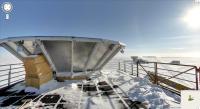
|
Google Streetview of the Dark Sector Lab roof. The Keck Array CMB telescope and Amundsen-Scott South Pole Station can be seen behind the BICEP2 ground shield (Google). |
| Download all visuals in one ZIP archive (84 MB) | ||
